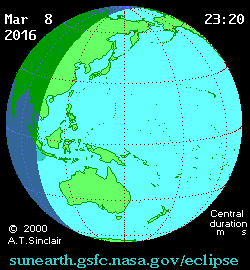| Total eclipse | |
 Totality with Baily's beads from Balikpapan, Indonesia | |
| Gamma | 0.2609 |
|---|---|
| Magnitude | 1.045 |
| Maximum eclipse | |
| Duration | 249 s (4 min 9 s) |
| Coordinates | 10°06′N148°48′E / 10.1°N 148.8°E |
| Max. width of band | 155 km (96 mi) |
| Times (UTC) | |
| Greatest eclipse | 1:58:19 |
| References | |
| Saros | 130 (52 of 73) |
| Catalog # (SE5000) | 9543 |
A total solar eclipse occurred at the Moon's descending node of orbit between Tuesday, March 8 and Wednesday, March 9, 2016, [1] [2] [3] [4] [5] with a magnitude of 1.045. A total solar eclipse occurs when the Moon's apparent diameter is larger than the Sun's and the apparent path of the Sun and Moon intersect, blocking all direct sunlight and turning daylight into darkness; the Sun appears to be black with a halo around it. Totality occurs in a narrow path across Earth's surface, with the partial solar eclipse visible over a surrounding region thousands of kilometres wide. Occurring about 1.25 days before perigee (on March 10, 2016, at 7:00 UTC), the Moon's apparent diameter was larger. [6]
Contents
- Path of the eclipse
- Maps
- Eclipse timing
- Places experiencing total eclipse
- Places experiencing partial eclipse
- Gallery
- Eclipse details
- Eclipse season
- Related eclipses
- Eclipses in 2016
- Metonic
- Tzolkinex
- Half-Saros
- Tritos
- Solar Saros 130
- Inex
- Triad
- Solar eclipses of 2015–2018
- Saros 130
- Metonic series
- Tritos series
- Inex series
- Notes
- References
- External links
Totality was visible from parts of Indonesia and Micronesia. A partial eclipse was visible for parts of Southeast Asia, East Asia, Alaska, northwestern Australia, and Hawaii. If viewed from east of the International Date Line (for instance from Hawaii), the eclipse took place on March 8 (Tuesday) (local time) and elsewhere on March 9 (Wednesday). [7]
The eclipse was clearly visible in many parts of Indonesia, including Central Sulawesi and Ternate, but obscured by clouds and smokes in Palembang, the largest city on the path of totality. [8] [9] The eclipse coincided with Nyepi, a public holiday in Indonesia and the end of the Balinese saka calendar. Because Nyepi is normally a day of silence, Muslims in Bali had to be given special dispensation to attend special prayer services during the eclipse. [10]




























































































































